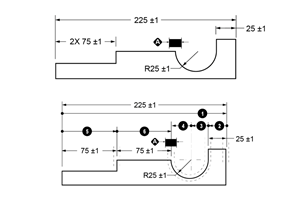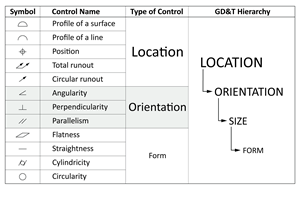It's All About the Geometry
Survey respondents from around the world report that while new technology is affecting how they receive and process design data, the transition has been gradual.
Geometry, as moldmakers well know, is not just a class taken in high school and then forgotten. It is an essential aspect of the day-to-day business operations of any given moldmaker. And with the many changes occurring almost daily in technology, design definition information is now being provided in a variety of forms. However, while all the excitement may now be focusing on the new technology, moldmakers are reporting that things are generally business as usual with regard to file transfers.
In fact, according to CIMdata, Inc. (Ann Arbor, MI) - a consulting firm that helps companies to develop innovative and profitable products in the evolving global e-business environment - the electronic transfer of surfaces is the most common method by which moldmakers currently receive design data. The report, The Worldwide Moldmaking Environment and How to Compete, written by Alan Christman and Jeann, Naysmith of CIMdata, shows that more than half of the data moldmakers receive worldwide is transferred this way (52.6 percent), and while this number is predicted to decrease during the next two years, it still will represent roughly half of the design data being transferred (48.5 percent).
Of those numbers, North American moldmakers receive surfaces more frequently than their European counterparts - 59.3 percent of North American moldmakers versus 50.3 percent of European ones. These numbers are expected to drop in the next two years to 54.3 percent for North American moldmakers and 49 percent for European moldmakers. In Japan, the report shows that the electronic transfer of surfaces accounts for approximately 35 percent of the models, and is expected to decrease to 25 percent throughout the next two years.
In contrast, only 20.6 percent of North American moldmakers and 25.9 percent of European moldmakers transfer solids electronically. Both anticipate these numbers to increase during the next two years - to 31 percent of North Americans and 35.9 percent of Europeans. In Japan, however, only 20 percent of models are now received as solids, but CIMdata predicts that this number will increase dramatically to 45 percent throughout the next two years.
According to the report, moldmakers still receive more than 15 percent of their designs on paper or other hard copy, but this is expected to decline greatly during the next two years to about 7.8 percent. Japanese moldmakers, meanwhile, receive nearly 25 percent of their models on paper, but they expect this to decline to around 15 percent throughout the next two years.
The study also finds that European moldmakers use prototypes more frequently than Americans. In fact, only 0.7 percent of American moldmakers report using prototypes, compared to five percent of Europeans. Neither expects a dramatic change during the next two years. In Japan, moldmakers report that they currently receive about 15 percent of their models as prototypes, and they expect this to decline slightly throughout the next two years.
Dimensional Trends
The times are changing for moldmakers in terms of 2-D versus 3-D geometry. While only a few years ago modeling and NC programming was done primarily through 2-D geometry, moldmakers now find themselves in a transition to using 3-D programming. As a result, approximately two-thirds of modeling is now done in 3-D geometry, and this amount is expected to increase to more than 80 percent in two years. In addition, 74.7 percent of respondents reported using 3-D geometry for NC programming. This number is expected to increase to around 82 percent during the next two years (see Figure 1).
| Form Geometry Being Employed in Manufacturing Modeling and NC Programming | Usage by North American Moldmakers | Usage by European Moldmakers | Usage by Moldmakers Worldwide | |||
| Current % | % In 2 Years | Current % | % In 2 Years | Current % | % In 2 Years | |
| Modeling - 2-D | 25.3 | 16.4 | 39.2 | 26.1 | 32.2 | 19.5 |
| Modeling - 3-D | 74.7 | 83.6 | 60.8 | 73.9 | 67.8 | 80.5 |
| Total Modeling | 100.0% | 100.0% | 100.0% | 100.0% | 100.0% | 100.0% |
| NC Programming - 2-D | 19.5 | 18.0 | 28.9 | 15.0 | 25.3 | 18.0 |
| NC Programming - 3-D | 80.5 | 82.0 | 71.1 | 85.0 | 74.7 | 82.0 |
| Total NC Programming | 100.0% | 100.0% | 100.0% | 100.0% | 100.0% | 100.0% |
| Figure 1: Current and future use of 2-D and 3-D geometry in manufacturing modeling and NC programming. | ||||||
It is interesting to note that North American moldmakers model in 3-D more than European moldmakers (74.7 percent versus 60.8 percent). But both of these percentages are higher than in Japan, where only 40 percent of models are created in 3-D.
However, according to CIMdata, all moldmakers surveyed will be moving to an increased use of 3-D modeling. In fact, in two years, it is expected that nearly 85 percent of models in North American shops as well as nearly 75 percent in European shops will be created in 3-D. In Japan, the number is projected to jump from 40 percent to 75 percent in the same timeframe.
Currently, 3-D geometry is used more frequently for NC programming than for modeling. Approximately 80 percent of programs are generated from 3-D models in North America, versus around 70 percent in Europe. In Japan, about 65 percent of the NC programs are done using 3-D geometry.
The Software Side
To accomplish modeling and NC programming, moldmakers are looking for the right software. According to CIMdata, of the three options offered - a product focused on moldmakers, an integrated CAD/CAM offering or a generic "Best in Class" offering - 44.1 percent of respondents worldwide prefer to have a product specifically designed for and focused on moldmakers. While most products out there now are either a generic CAD/CAM product or a CAM-centric product, it appears that moldmakers are looking for something more. Geographically, 52.9 percent of North American moldmakers preferred an industry-focused product, compared to 38.9 percent of European respondents.
In comparison, 37.3 percent of respondents worldwide preferred an integrated CAD/CAM offering (32.4 percent of North Americans versus 38.9 percent of Europeans) and 18.6 percent would look for a generic "Best in Class" offer (14.7 percent of North Americans versus 22.2 percent of Europeans). More than half of the Japanese respondents prefer an integrated CAD/ CAM product.
Related Content
What Is Scientific Maintenance? Part 1
Part one of this three-part series explains how to create a scientific maintenance plan based on a toolroom’s current data collection and usage.
Read MoreTolerancing in Mold Design, Part 1: Understanding the Issues of Conventional Bilateral Tolerancing
Mold designers must understand the location, orientation and form limitations of conventional tolerancing before changing to another dimensioning system.
Read MoreFour Micro Tooling Considerations
Issues involving gating, ejection, mold splits and direction of pull are of special concern when it comes to micro tooling.
Read MoreTolerancing in Mold Design, Part 2: Using GD&T to Address Conventional Tolerancing Issues
Mold designers can achieve a single interpretation of workpiece functionality when following the American Society of Mechanical Engineers Geometric Dimensioning and Tolerancing standard.
Read MoreRead Next
How to Use Strategic Planning Tools, Data to Manage the Human Side of Business
Q&A with Marion Wells, MMT EAB member and founder of Human Asset Management.
Read MoreHow to Use Continuing Education to Remain Competitive in Moldmaking
Continued training helps moldmakers make tooling decisions and properly use the latest cutting tool to efficiently machine high-quality molds.
Read MoreAre You a Moldmaker Considering 3D Printing? Consider the 3D Printing Workshop at NPE2024
Presentations will cover 3D printing for mold tooling, material innovation, product development, bridge production and full-scale, high-volume additive manufacturing.
Read More




















